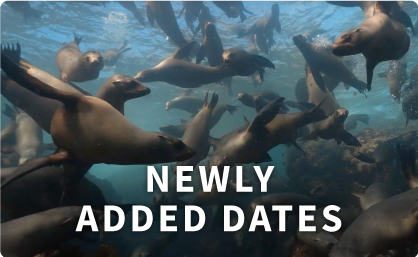Did you know?! The animals of Guadalupe Island include more than just great white sharks (Carcharodon carcharias)! The island was once home to out of control billy goats and is now a sanctuary for pinnipeds including Guadalupe fur seals and northern elephant seals.
Guadalupe Fur Seals
You will be able to see Guadalupe fur seals (Arctocephalus townsend) on the beach when we get to our anchorage. The males are much larger than females, and both sexes are dark brown or dusky black in colour. With the use of our binoculars, you might be able to see their visible earflaps which confirms that they are not a “true seal” (Phocidea). The species was exterminated in the state of California by 1825. Hunting by both Russian and American sealers continued on Guadalupe Island through 1894, which reduced the population to less than 20 animals. Fortunately, the population has since recovered to over 10,000 in number!
Northern Elephant Seals
We are also sure to see northern elephant seals (Mirounga angustirostris) on the beach at Guadalupe Island, which is an amazing thing. These “true seals” (no earflaps!) were believed to have been hunted to extinction by 1884. However, in 1892, a Smithsonian expedition discovered a remnant population of 8 animals right on the beach that we anchor in front of. It’s inconceivable to us but the scientific expedition murdered most of the remaining elephant seals for their collection. Somehow the elephant seals managed to survive until they were fully protected by the government of Mexico in 1922. The population has since recovered to over 100,000 animals! They now range from Guadalupe Island as far north as British Columbia, Canada. We have actually seen them diving at Race Rocks off Victoria, in British Columbia! Interesting note: the males can grow to 5,000 pounds (2,276 kilos) or greater!
Billy Goat Madness
The story of the animals of Guadalupe Island is not complete without mention of an out of control population of billy goats! Conservationists believe that non-endemic goats were introduced to the island in the 18th century as a self-perpetuating source of meat for ships trading in the area. A never-ending smorgasbord for sailors if you will. The problem with the introduction of a non-endemic species in a closed ecosystem is that one runs the risk of destroying the ecology of the area, and that is exactly what happened. The goat population multiplied like crazy and one-third of the flora and fauna was wiped out completely. The goat population was reduced by hunting and trapping to approximately 15,000 animals by the turn of the 21st century. Then the Grupo de Ecologia y Conservacion de Islas, with the support of the Mexican government, succeeded in eliminating the last of the population using “Judas goats.” The Judas goats were captured, sterilized, tagged and then released back into the island’s wilderness where these goats led animal control teams to where other goats could be found and then killed. Once one herd was eliminated, the Judas goats were released into the wild again to find and “betray” more of their friends. Sad but necessary.
The Animals of Guadalupe Island Make it Spectacular
Guadalupe Island of today is a wonderful experience. Vibrant and healthy. It has been a nature conservancy area since August 16, 1928, making it one of the oldest reserves in Mexico. It has been a pinniped sanctuary since 1975. It is now a biosphere reserve protected under Mexican law. Best of all for us, it is home to the best great white shark diving on the planet with crystal clear conditions and a healthy population of sharks.
Dive safe!
–Captain Mike
For more information, read part one of this series, the history of Guadalupe Island!
📷 By CillanXC. CC BY-SA 3.0, via Wikimedia Commons








